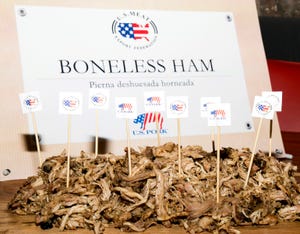The pressure is mounting to enhance the current identification (ID) system for sows as another step toward safeguarding the U.S. pork industry from domestic and foreign animal diseases, while preserving crucial exports
September 22, 2010

The pressure is mounting to enhance the current identification (ID) system for sows as another step toward safeguarding the U.S. pork industry from domestic and foreign animal diseases, while preserving crucial exports.
And increasingly, purveyors of bratwurst and ballpark franks are pressuring sow suppliers to certify farm of origin.
Industry leaders say the answer is a pink-colored plastic ear tag, approved by the U.S. Department of Agriculture (USDA) about 2½ years ago, to identify cull sows shipped to slaughter.
Patrick Webb, DVM, director of Swine Health Programs for the National Pork Board, says a few large pork producers have already adopted the pink tag.
Back Tags Fall Short
Most producers still rely on back tags for sow ID, which have been used to meet ongoing disease traceback requirements for pseudorabies and swine brucellosis control programs for several decades.
However, the back tag is not the best tool we have available as a reliable means of sow identification, points out Dallas McDermott, Swine ID program manager for the Pork Board.
“While traceback is achievable under the current system, we can make it better using the new tags,” he observes. “We think that with this new tag, we can improve retention rate to over 90%, as well as improve the speed and accuracy of traceback.”
For sows, the identification challenge is different than for nursery and finishing pigs, in that they are identified by a group lot number and usually stay together as a group through marketing.
Cull sows brought to a collection point are ultimately sorted into semi-loads according to packer weight preferences and sausage requirements, explains James McKean, DVM, Extension veterinarian and associate director of the Iowa Pork Industry Center at Iowa State University. Consequently, sows from several farms will make up any given load.
Therefore, tracking sows to their origin requires chasing down different links in the supply chain, starting with the packer, back through collection points or buying stations, and finally back to the farm.
Back-tagging sows is supposed to provide a random sample of sow health, but it has been compromised by the failure of back tags to remain on sows through marketing channels, McKean says.
Back-tagging sows is often done after sows arrive at collection points or sales barns, he says. By law, sow ID is supposed to be done at the first point of concentration.
Premises Identification
“Premises ID, used for group lot identification of market hogs, offers the opportunity of individual identification of sows that supports animal disease traceability through the marketing chain,” remarks McKean. The system offers flexibility. The pink tag can be used with just the seven alphanumeric premise ID numbers as a simple sow slaughter tag, or farm production information can be included on the tag. A third option is to place a separate pink tag in the other ear.
“If you’ve got sows in pens, you may want to put the pink tag in at the time that they are getting loaded for market. I think we will see more producers doing that as we move to electronic ID and the use of feeding stations. Producers will put an electronic feeding tag in one ear, and when those sows are ready to go to market, they will pull that tag out so they can recycle it and stick in a premises tag,” he explains.
Waiting to tag sows until just prior to shipment to slaughter helps prevent penmates from chewing on them and pulling them out.
For sows in stalls, producers can easily attach a premises tag that includes both the premises identification number and the production management number on the same ear tag, McKean reinforces.
Disease Surveillance
The value of a standardized sow ID system that McKean envisions is one that permits disease surveillance screening by collecting the tag and a blood/tissue sample at slaughter and sending both to a processing lab. The bar code on the underside of the pink tag contains the farm’s premises ID number. This number could be scanned and those premises ID numbers placed in a database to determine origin of samples.
Then if the United States becomes involved in a national disease surveillance and eradication program, regulators can compare sow IDs that have already been tested from that farm and determine whether further testing is required.
“It becomes part of an organized collection and sample selection program that is truly representative of the herds, as opposed to simply being representative of the animals that retained back tags,” McKean points out.
And this type of surveillance effort — combining market hog and sow identification — is invaluable when monitoring for classical swine fever or other foreign animal diseases during an emergency response, Webb adds.
“I am very supportive of premises ID numbers and their application to emergency response, and how fast and effectively we can respond to a foreign animal disease threat,” he continues.
ID Registration
For producers to acquire the new sow tags, they must first obtain a nationally recognized, seven-character
premises ID number (PIN) from the office of their state veterinarian or board of animal health, Webb says. The Pork Checkoff’s Pork Quality Assurance-Plus program requires that all producers have a national PIN that identifies their farm when having their sites assessed, he adds.
McDermott, under contract with the Pork Board to do outreach and education, says Allflex, Destron-Fearing and Raytec have all been USDA-approved as authorized distributors of the pink tags. The pink tags can be produced with only the seven-digit premises identification number at the top of the tag, or with the PIN and a unique production management number, if the producer chooses. Each sow tag will cost about 60 cents to $1.
McKean says the ID information will allow sow plants to easily monitor pork quality, such as broken needles and other physical hazards, and other pathologic conditions in the cull animals they are buying.
Pork Checkoff Stays With Swine ID
Just because the U.S. Department of Agriculture abandoned the National Animal Identification System (NAIS), that doesn’t mean the pork industry has changed its direction or resolve when it comes to swine identification.
The tools that made up the system, premises identification (ID) generator and repository, are still working, and states can access that information, explains Patrick Webb, DVM, director of Swine Health Programs for the National Pork Board.
Pork producers still have the ability to obtain a premises ID for their farm if they haven’t already done so, he notes. The process is the same — call the state veterinarian’s office or the board of animal health for premises registration information, or visit their Web sites.
The pork industry’s Swine ID Implementation Task Force has been implementing the industry-approved program standards since 2004. The first phase encourages producers to get a premises ID for each production site. Currently, an estimated 82% of swine farms have a premises ID.
The second phase is helping producers understand the group lot and individual animal ID standards. Phase 3 focuses on recordkeeping – using premises identification numbers to ID farms, Webb says. The new sow ID effort discussed in the adjacent article is part of that phase 2 activity.
The Pork Board also recently developed the capability for producers to print barcode labels of their premises identification numbers. “This capability was necessary as implementation progresses,” Webb says. “According to the swine ID program standards, producers will need to provide a premises ID to the packer when delivering market hogs to harvest, and a barcode on the bill of lading seems to be a good way to deliver that information.”
Producers interested in learning more about a premises ID for their farm can go to www.pork.org, click on “programs,” then scroll down to “swine ID” for information on registering their premises.
You May Also Like



